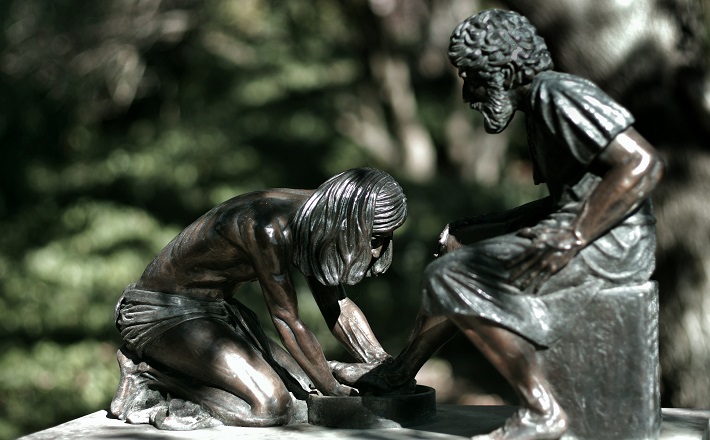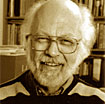Commentary on Exodus 12:1-4 [5-10] 11-14
This Passover text is appointed for Maundy Thursday each year.1
According to the Synoptic Gospels, it is on Thursday evening that Jesus, in the upper room with his disciples, celebrates Passover and institutes the Lord’s Supper (Matthew 26:17-29; Mark 14:12-25; Luke 22:7-28). The Gospel of John, however, speaks of the Thursday supper as the day before Passover (13:1; 19:14), linking Jesus’ death on Friday with the Passover sacrifices. In either case, the image of “paschal lamb” for Jesus Christ is appropriate (John 1:29; I Corinthians 5:7-8).
This Passover text is a part of the larger narrative Exodus 1:1-15:21, a story of liberation from bondage in Egypt. This literary context is important. The story of the ten plagues (beginning at Exodus 7:8) is “interrupted” by Exodus 12:1-28. In Exodus 11:1 God had announced “one more plague” upon Pharaoh and the Egyptians. The reader expects the tenth plague to follow immediately, but it is delayed until Exodus 12:29. Between the announcement and the event, there is an extensive liturgical discussion regarding Passover/Unleavened Bread.
Why this break in the narrative?
Most basically, the story of the tenth plague (12:29) must be read through the liturgical lens provided by Exodus 12:1-28. The effect: the tenth plague is presented not simply as historical event but also as liturgical event (merged in 12:50-51). The liturgy is set in place before the event occurs and so the event is liturgy, the first celebration of Passover. This means that the liturgical event is as much “act of God” as is the historical event. That is, Passover is not simply a time of commemoration, it has a sacramental character: in and through this particular ritual (often dramatized, see Deuteronomy 16:1-8; Numbers 9:1-14; 28:16-25; Leviticus 23:4-8) God acted and acts in a saving way. As God delivered Israel in ancient times, so also in every celebration of Passover God works salvation for the believing community.
The origins and history of Passover may be in dispute, but its basic significance stands strong. Passover is a means of grace. Exodus 12:11b-14 provides specific language for this understanding. It is “the Lord’s passover” (12:11) because it centers on what God does. God will “pass over” those houses with blood-smeared entrances, delivering them from the “plague.” While the basic images are God’s salvation from bondage and shielding from death, also to be noted is the response of the community: they are to prepare for a journey (12:11). This saved community must be ready to go, must be prepared for a trek that will move through difficult terrain (12:11). The Jewish community has stressed these senses of Passover through the centuries: God brought us out of Egypt!
Passover is also described as a family ritual (a lamb without blemish killed; blood placed on the doorposts and lintel of the house; lamb eaten hurriedly with unleavened bread and bitter herbs); further details are given in verses 43-49. Notably, special provision is made for considering the questions that children may ask: “what does this mean?” (12:26-27; 13:8-10). Passing on the tradition to the children is essential to the proper keeping of Passover. Hence it has a special place in the ongoing formation of community identity; in view of such a function, Passover was later transformed into a national pilgrimage (Deuteronomy 16:1-8).
Also central to the text is the reference to blood in 12:13; its importance as a “sign” is its linkage to God’s promise (not the sign in and of itself). The blood is a sign of promise “for you” (Israel), not for God. God thereby commits the divine self to pass over the blood-marked houses and deliver its occupants. Israel can rely on God’s being faithful to this promise. The blood is more than a marker (as if any colorful substance would do). It represents a life given and that provides life for Israel. The blood has this power because of the promising word of God. The placement of the blood can also be viewed as a tangible sign of the faith of those living in each household and the faith of the worshiper is not irrelevant to God. At the same time, the blood of the Passover lamb is not said to atone for the sin of the people. Also, no substitutionary language is associated with the blood of the Passover lamb. The theme of salvation is the prominent image for Passover (see Exodus 15:2) rather than the theme of forgiveness. The New Testament linkage of Passover with the Lord’s Supper does include the language of forgiveness beyond what Passover originally signified (see Matthew 26:27-28).
Later celebrations of Passover in Israel influenced the telling of the Exodus story; liturgy has shaped literature. This way of presenting the material gives to the tenth plague a character not unlike a Christmas pageant gives to the birth of Jesus. The result is a somewhat more impressionistic imaging of the actual event than the other nine plagues. This understanding could help readers understand the violence, especially the death of the firstborn as God’s own action. The killing of the firstborn should not be interpreted in a precisely literal way, as if God “shot” each one individually. Its concern is to state that no household remained untouched. Moreover, the text uses several words to speak of a non-divine agent: plague (11:1) or blow/plague (12:13) or pestilence (9:15; cf. 9:3) or destroyer (12:23). It is best to think of a pestilence epidemic that kills quickly.
Moreover, as with the other plagues, the emphasis on “all” portrays how devastating the event was for Egypt. And why the firstborn? The firstborn are thought to belong to God (see 13:1-2). Moreover, the language of Exodus 1:22 and 4:22-23 reminds readers that Pharaoh’s action against Israel’s male children amounted to genocide; so the tenth plague, though not as serious, is understood in a “what goes around, comes around” sense. Finally, God executes judgment on “all the gods of Egypt.” This language reflects an Egyptian understanding that the Pharaoh was divine and God makes a key point: “You shall have no other gods before me.”
1. Commentary first published on this site on April 21, 2011.


April 13, 2017